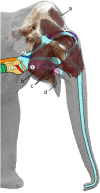A novel theory of Asian elephant high-frequency squeak production
- PMID: 34134675
- PMCID: PMC8210382
- DOI: 10.1186/s12915-021-01026-z
A novel theory of Asian elephant high-frequency squeak production
Erratum in
-
Author Correction to: A novel theory of Asian elephant high-frequency squeak production.BMC Biol. 2021 Nov 4;19(1):237. doi: 10.1186/s12915-021-01173-3. BMC Biol. 2021. PMID: 34736456 Free PMC article. No abstract available.
Abstract
Background: Anatomical and cognitive adaptations to overcome morpho-mechanical limitations of laryngeal sound production, where body size and the related vocal apparatus dimensions determine the fundamental frequency, increase vocal diversity across taxa. Elephants flexibly use laryngeal and trunk-based vocalizations to form a repertoire ranging from infrasonic rumbles to higher-pitched trumpets. Moreover, they are among the few evolutionarily distantly related animals (humans, pinnipeds, cetaceans, birds) capable of imitating species-atypical sounds. Yet, their vocal plasticity has so far not been related to functions within their natural communicative system, in part because not all call types have been systematically studied. Here, we reveal how Asian elephants (Elephas maximus) produce species-specific squeaks (F0 300-2300 Hz) by using acoustic camera recordings to visualize sound emission and examining this alongside acoustic, behavioral, and morphological data across seven captive groups.
Results: We found that squeaks were emitted through the closed mouth in synchrony with cheek depression and retraction of the labial angles. The simultaneous emission of squeaks with nasal snorts (biphonation) in one individual confirmed that squeak production was independent of nasal passage involvement and this implicated oral sound production. The squeaks' spectral structure is incongruent with laryngeal sound production and aerodynamic whistles, pointing to tissue vibration as the sound source. Anatomical considerations suggest that the longitudinal closed lips function as the vibrators. Acoustic and temporal parameters exhibit high intra- and inter-individual variability that enables individual but no call-subtype classification. Only 19 of 56 study subjects were recorded to squeak, mostly during alarming contexts and social arousal but some also on command.
Conclusion: Our results strongly suggest that Asian elephants force air from the small oral cavity through the tensed lips, inducing self-sustained lip vibration. Besides human brass players, lip buzzing is not described elsewhere in the animal kingdom. Given the complexity of the proposed mechanism, the surprising absence of squeaking in most of the unrelated subjects and the indication for volitional control, we hypothesize that squeak production involves social learning. Our study offers new insights into how vocal and cognitive flexibility enables mammals to overcome size-related limitations of laryngeal sound production. This flexibility enables Asian elephants to exploit a frequency range spanning seven octaves within their communicative system.
Keywords: Acoustic allometry; Bioacoustics; Communication; Functional morphology; Sound visualization; Vocal learning; Vocal signals.
Conflict of interest statement
The authors declare that they have no competing interests.
Figures






Similar articles
-
Visualizing sound emission of elephant vocalizations: evidence for two rumble production types.PLoS One. 2012;7(11):e48907. doi: 10.1371/journal.pone.0048907. Epub 2012 Nov 14. PLoS One. 2012. PMID: 23155427 Free PMC article.
-
Sound Visualization Demonstrates Velopharyngeal Coupling and Complex Spectral Variability in Asian Elephants.Animals (Basel). 2022 Aug 18;12(16):2119. doi: 10.3390/ani12162119. Animals (Basel). 2022. PMID: 36009709 Free PMC article.
-
Operant control and call usage learning in African elephants.Philos Trans R Soc Lond B Biol Sci. 2021 Oct 25;376(1836):20200254. doi: 10.1098/rstb.2020.0254. Epub 2021 Sep 6. Philos Trans R Soc Lond B Biol Sci. 2021. PMID: 34482733 Free PMC article.
-
Vocal communication in African elephants (Loxodonta africana).Zoo Biol. 2010 Mar-Apr;29(2):192-209. doi: 10.1002/zoo.20251. Zoo Biol. 2010. PMID: 19434672 Review.
-
Vocal learning in elephants: neural bases and adaptive context.Curr Opin Neurobiol. 2014 Oct;28:101-7. doi: 10.1016/j.conb.2014.07.001. Epub 2014 Jul 23. Curr Opin Neurobiol. 2014. PMID: 25062469 Free PMC article. Review.
Cited by
-
Acoustic structure and information content of trumpets in female Asian elephants (Elephas maximus).PLoS One. 2021 Nov 23;16(11):e0260284. doi: 10.1371/journal.pone.0260284. eCollection 2021. PLoS One. 2021. PMID: 34813615 Free PMC article.
-
Author Correction to: A novel theory of Asian elephant high-frequency squeak production.BMC Biol. 2021 Nov 4;19(1):237. doi: 10.1186/s12915-021-01173-3. BMC Biol. 2021. PMID: 34736456 Free PMC article. No abstract available.
-
Vocal Creativity in Elephant Sound Production.Biology (Basel). 2021 Aug 5;10(8):750. doi: 10.3390/biology10080750. Biology (Basel). 2021. PMID: 34439982 Free PMC article.
-
Acknowledging the Relevance of Elephant Sensory Perception to Human-Elephant Conflict Mitigation.Animals (Basel). 2022 Apr 14;12(8):1018. doi: 10.3390/ani12081018. Animals (Basel). 2022. PMID: 35454264 Free PMC article. Review.
-
Biphonation in animal vocalizations: insights into communicative functions and production mechanisms.Philos Trans R Soc Lond B Biol Sci. 2025 Apr 3;380(1923):20240011. doi: 10.1098/rstb.2024.0011. Epub 2025 Apr 3. Philos Trans R Soc Lond B Biol Sci. 2025. PMID: 40176517 Free PMC article. Review.
References
-
- Elliott SJ, Bowsher JM. Regeneration in brass wind instruments. J Sound Vib. 1982;83(2):181–217. doi: 10.1016/S0022-460X(82)80086-2. - DOI
-
- Fabre B, Gilbert J, Hirschberg A, Pelorson X. Aeroacoustics of musical instruments. Annu Rev Fluid Mech. 2012;44(1):1–25. doi: 10.1146/annurev-fluid-120710-101031. - DOI
-
- Fant G. Acoustic theory of speech production. the Hague: Mouton & Co; 1960.
-
- Titze IR. Principles of voice production (second printing) Iowa City: National Center for Voice and Speech; 2000.
Publication types
MeSH terms
Grants and funding
LinkOut - more resources
Full Text Sources
Miscellaneous

